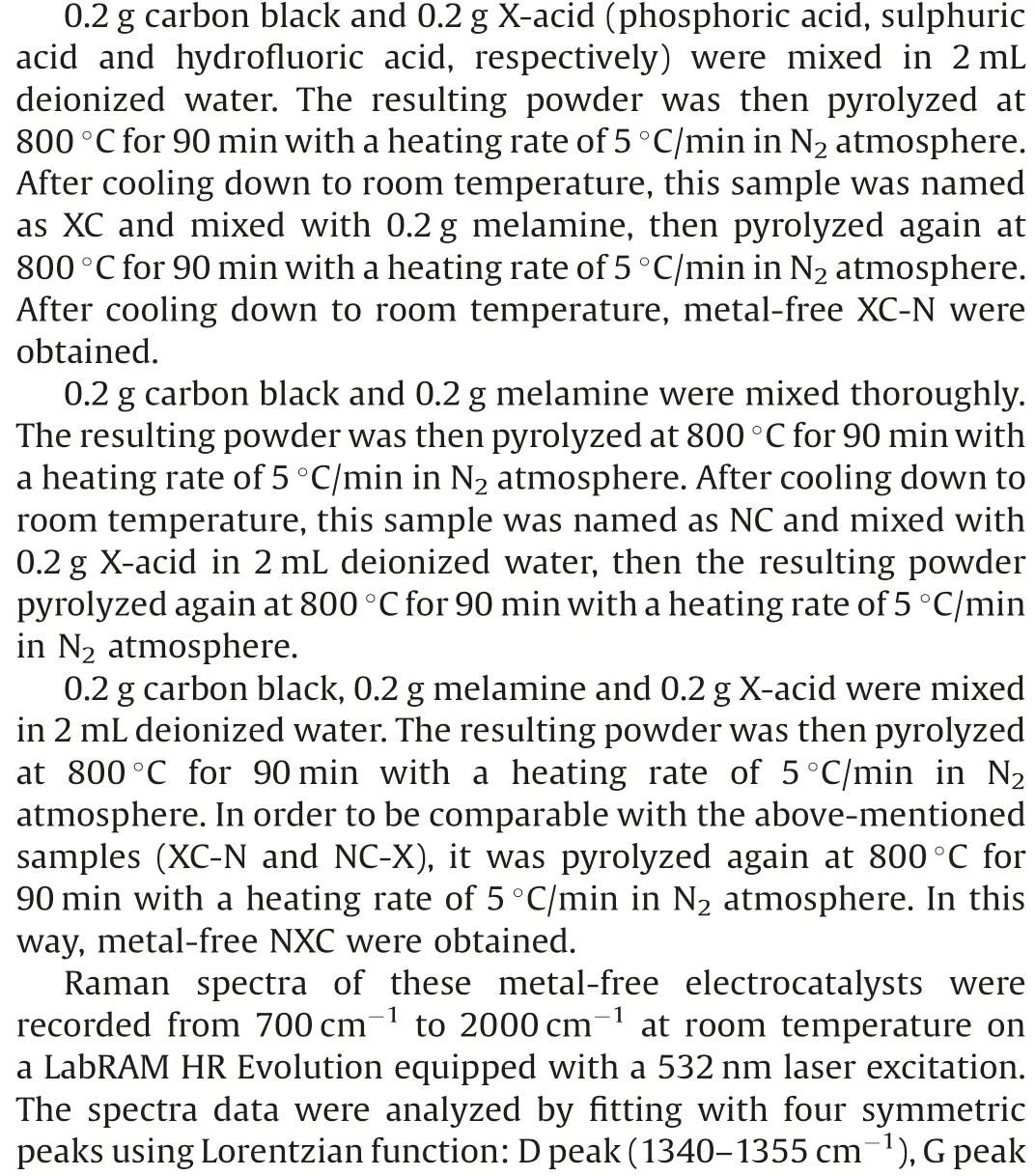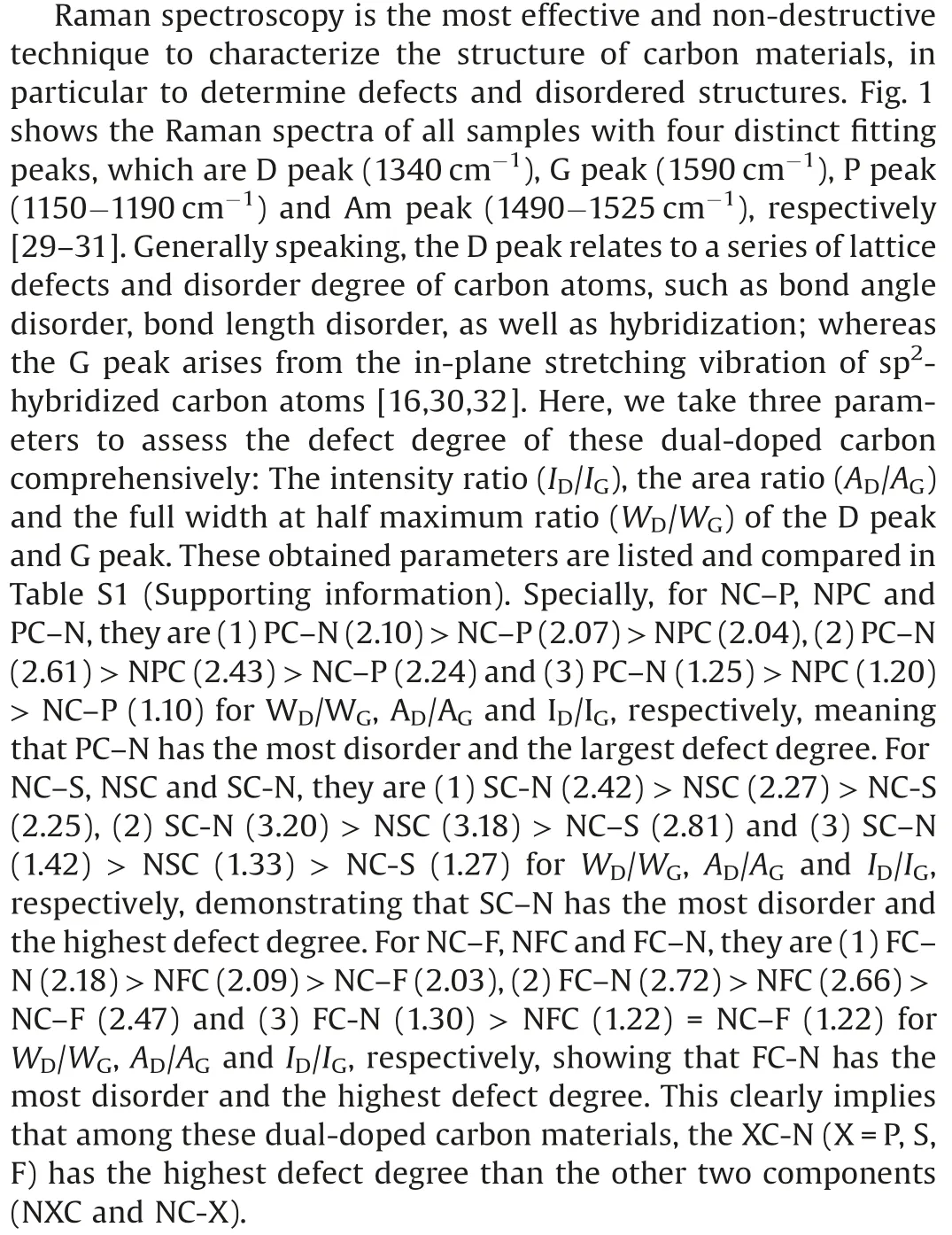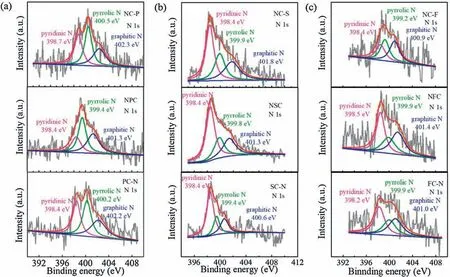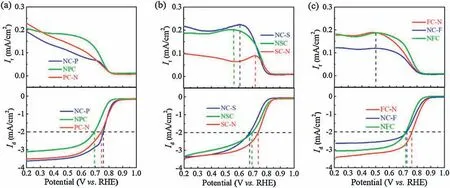Effect of doping order on metal-free heteroatoms dual-doped carbon as oxygen reduction electrocatalyst
2021-05-14HuiJunZhngJingGngChunliCiZiFngZhongWnliYoJunhYng
Hui-Jun Zhng*,Jing Gng,Chunli Ci,Zi-Fng M,Zhong M,Wnli Yo,Junh Yng
a School of Materials Science and Engineering, University of Shanghai for Science and Technology, Shanghai 200093, China
b Department of Chemical and Biomolecular Engineering, University of Illinois at Urbana-Champaign, Urbana, Illinois 61801, United States
c Department of Chemical Engineering, Shanghai Jiaotong University, Shanghai 200240, China
d Department of Chemical Engineering, Waterloo Institute for Nanotechnology (WIN), University of Waterloo, Waterloo, Ontario N2L3G1, Canada
e Jiangxi Key Laboratory of Power Battery and Material, Faculty of Materials Metallurgy and Chemistry, Jiangxi University of Science and Technology,Ganzhou 341000, China
ABSTRACT Metal-free heteroatoms dual-doped carbon has been recognized as one of the most promising Pt/C-substitutes for oxygen reduction reaction (ORR).Herein, we optimize the preparation process by doping order of metal-free heteroatoms to obtain the best electrocatalytic performance through three types of dual-doped carbon, including XC-N (first X doping then N doping), NC-X (first N doping then X doping)and NXC(N and X doping)(X=P,S and F).XC-N has more defect than the other two indicated by Raman spectra.X-ray photoelectron spectrom(XPS)measurements indicate that N and X have been dual-doped into the carbon matrix with different doping contents and modes.Electrocatalytic results,including the potential of ORR peak(Ep),the half-wave potential,the diffusion-limiting current density mainly follows the order of XC-N>NC-X>NXC.Furthermore, the synergistic effect of second atom doping are also compared with the single doped carbon (NC, PC, SC and FC).The differences in electronegativity and atomic radius of these metal-free heteroatoms can affect the defect degree, the doping content and mode of heteroatoms on carbon matrix,induce polarization effect and space effect to affect O2adsorption and product desorption, ultimately to the ORR electrocatalytic performance.
Keywords:Oxygen reduction reaction Metal-free electrocatalyst Heteroatoms dual-doped carbon Doping order N, P, S and F
Owing to the zero-emission and high-efficiency,fuel cells have been receiving much attention as clean energy conversion systems.Their performances are significantly governed by the cathode oxygen reduction reaction (ORR), which is in a sluggish reaction kinetics with multi-electron transfer [1–4].So far, carbon supported precious metal platinum (Pt/C) are still the most efficient ORR electrocatalysts.However, these elelctrocatalysts always suffer from several drawbacks, such as high cost with scarcity, poor stability, low methanol tolerance.To solve these problems, extensive efforts have been made to develop nonprecious metals or even metal-free ORR electrocatalysts [1–5].
In 2009, Dai’s group first reported that vertically aligned nitrogen-containing carbon nanotubes (VA-NCNTs) can use as a metal-free electrocatalyst with a better ORR electrocatalytic activity,long-term stability and tolerance to crossover effect than Pt/C in alkaline fuel cells [6].Since then, heteroatom nitrogendoped carbon nanomaterials,such as carbon nanotubes,graphene and carbon blacks, have been widely studied and considered as the promising metal-free ORR electrocatalysts[6–10].For example,a three-dimensional nitrogen-doped carbon nanotubes/graphene(3D NCNTs/G) was prepared by pyrolysis of pyridine over a graphene-sheet-supported Ni and displayed a higher ORR activity and selectivity in alkaline electrolyte compared with undoped CNTs/G [7].It was believed that the different electronegativities between the heteroatom N(3.04)and the C atom(2.55)can break the electroneutrality of adjacent carbon atoms to create positive/negative charged sites,which were favorable for O2adsorption and charge transfer in the ORR process [6].
With this knowledge in mind, some researchers recently have also found that co-doping of N with other metal-free heteroatoms,such as P, S and F, into carbon materials can further improve the electrocatalytic activity of N single-doped carbon materials for the ORR[11–27].This situation is mainly attributed to the synergistic effect that arises from the other heteroatoms,resulting in a larger asymmetrical spin and higher charge density than that achieved by N single heteroatom doping[11–20].For instance,Xing’s group has found that the incorporation of sulfur into nitrogen-doped carbon(S-NC)can dramatically improve the selectivity of ORR to H2O than NC [18].They also revealed that S-doping can reduce the energy barrier of the O2(ads)hydrogenation to form OOH(ads), leading to enhanced intrinsic activity by theoretical research [18].Considering the highest electronegativity and the smallest atomic radius of F.Zhang and coworkers have prepared NFC electrocatalysts from a melamine hydrogen flouride salt and found an obvious synergistic effect from N and F[16].Hu’s group has compared two kinds of B and N dual-doped carbon nanotubes dominated by bonded or separated B and N, and found that the separated one had better ORR electrocatalysts by the experimental and theoretical results[20].Xia’s group predicted the synergistic effect of co-doping occurs within a certain distance between each dopant and pointed out several design principles[28].Here,we are very curious about whether there is any doping order effect of these heteroatoms for metal-free co-doepd carbon electrocatalysts?
On the basis of the differences in electronegativity between metal-free heteroatoms (N: 3.04, P: 2.19, S: 2.58, F: 3.98) and carbon atom (C: 2.55) as well as atomic radius of metal-free elements(N:0.075 nm,P:0.110 nm,S:0.102 nm,F:0.071 nm)and carbon atom (C: 0.077 nm) in the elemental periodic table as shown in Fig.S1a (Supporting information), in this study, we choose several heteroatoms, P, S and F, to understand the doping order effect on metal-free heteroatoms dual-doped carbon as ORR electrocatalysts,althogh many attention has been focused on dual-doped of metal-free heteroatoms on carbon nanomaterials[11–20].
In view of the different electronegativity and atomic radius of metal-free elements N, P, S and F, as shown in Fig.S1a, we here design multiple parallel experiments in order to understand the effect of metal-free heteroatoms doping order on the structure and electrocatalytic performance of dual-doped carbon electrocatalysts.The detail description of these multiple parallel experiments are as follows.


Electrochemical measurements,such as cyclic voltammograms(CVs), rotating disk electrode (RDE) and rotating ring-disk electrode (RRDE) measurements, were performed on the CHI 760D in 0.1 mol/L KOH solution at room temperature.The electrocatalyst ink was prepared by ultrasonically dispersing 5 mg electrocatalyst powder in 950 mL anhydrous ethanol and 50 mL 5 wt% Nafion solution for 30 min.20 mL of this ink was deposited onto the surface of a RRDE (d = 5.61 mm) and air-dried for further use.A conventional three-electrode system,including a graphite rode, a saturated calomel electrode (SCE) and the electrocatalyst-coated RRDE were used as the counter electrode,the reference electrode and the working electrode, respectively.The potential scan range was set between-0.8 V and 0.2 V at a fixed potential scan rate of 5 mV/s.CVs were first collected in N2-saturated solution to obtain the background capacitive currents,then CVs were recorded in O2-saturated solution for the electrocatalytic ORR.The disk currents and the ring currents were recorded at a rotation rate of 900 rpm, furthermore, the disk potential was maintained at 0.5 V for the ring currents.

The doping content and mode of metal-free heteroatoms N,P,S and F on carbon are measured and analyzed by XPS.Quantitative results of doping content are displayed in Table S2 (Supporting information), indicating that N and metal-free heteroatoms (P, S and F) have been successfully dual-doped into the carbon matrix.The atomic contents of N are 1.26,1.75 and 1.52 for NC-P,NPC and PC-N,1.41,2.43 and 0.98 for NC-S,NSC and SC-N,0.84,1.09 and 0.82 for NC-F, NFC and FC-N, respectively.Fig.2 shows the high resolution N 1s spectra of these samples.Each one is mainly deconvoluted into three types:pyridinic N(398.4 eV),pyrrolic N(399.9 eV) and graphitic N (401.3 eV), which are typically observed in N-doped carbon [16,30,32–34].Graphitic N corresponds to N atoms that are doped into carbon matrix by substitution the carbon atoms in hexagonal ring, while pyrrolic N refers to having two p electrons and p-conjugated bond system of N atoms and pyridinic N refers to the N atom in N-doped carbon surface on the edge of two carbons.Furthermore,the percentage of each component is about 30% as listed in Table S2.

Fig.1.Raman spectra with four fitting peaks (D peak, G peak, P peak and Am peak) of (a) NC-P, NPC and PC-N; (b) NC-S, NSC and SC-N; and (c) NC-F, NFC and FC-N.
The atomic contents of P are 0.43%,1.12% and 0.46% for NC-P,NPC and PC-N, respectively.The high resolution P 2p spectra in Fig.S2a (Supporting information) is deconvoluted into two different signals at about 133 eV and 134 eV with binding energies analogous to 2p3/2and 2p1/2, respectively.The P 2p at 133 eV is attributed to the P-C coordination, which is favorable for oxygen molecule adsorption and 134 eV is thebonding [31,35,36].For NC–S,NSC and SC–N,the S content on carbon are 0.15%,0.07%and 0.20%, respectively.Fig.S2b (Supporting information) shows the high resolution S 2p spectra of these samples.In the high resolution S 2p spectra, it consists of two components at about 164 eV and 165 eV, which originate from the 2p3/2and 2p1/2of thiophene-S owing to their spin-orbit coupling, respectively[33,35].These two major peaks are attributed to the sulfur binding in C–S–C bond and conjugated -C=S- bond, respectively [31,26–30].These C–S–C and –C¼S– species have some contributors to ORR activity[31].Besides,the third peak at the binding energy of around 168.8 eV for the SC-N is from oxidized sulfur[34,36,37].The high resolution F 1s spectra of these samples are given in Fig.S2c (Supporting information).Two components attributing to the ionicF bond and semi-ionicF bond can be deconvoluted, respectively [12,16].

Fig.2.High resolution XPS spectra of N 1s in (a) NC-P, NPC and PC-N; (b) NC-S, NSC and SC-N; and (c) NC-F, NFC and FC-N.
The electrocatalytic performances of CVs for XC-N, NC-X and NXC(X=P,S and F)are compared and shown in Fig.3.The CVs in N2-saturated (dotted line) 0.1 mol/L KOH solution are featureless(no peak) for all samples, in contrast, a single well-defined ORR peak can be obtained in O2-saturated(solid line)solution for each one.In Fig.3a,the potential of ORR peak( Ep)shifts positively as the order of PC-N (784 mV) > NC-P (755 mV) > NPC (751 mV).The Epfollows the order of SC-N (783 mV) > NC-S (764 mV) > NSC(754 mV) in Fig.3b and FC-N (788 mV) > NC-F (773 mV) > NFC(759 mV) in Fig.3c.This means that XC-N has better electrocatalytic performances than NXC and NC-X (X=P, S and F).
To further investigate the electrocatalytic performances of XC-N,NC-Xand NXC(X=P,S and F),RDE and RRDE measurements are both conductedandcomparedinFig.4.Forthecurrent-potentialcurvesof the disk electrode in O2-saturated 0.1 mol/L KOH solution (at the bottom of Fig.4, a S-shaped curve for each sample is clearly displayed.Moreover, a more positive half-wave potential and a higher diffusion-limiting current density is generally occurred on XC-N,especially SC-N and FC-N,which is better than the other two types.For example,at the current density of 2 mA/cm2,SC-N has a half-wave potential of 740 mV,better than NC-S(677 mV)and NSC(695 mV)and FC-N has a half-wave potential of 764 mV,better than NC-F(727 mV)and NFC(718 mV).The ring currents as a function of the disk potential(at the top of Fig.4)initiate simultaneously as the disk currents,indicating the generation of peroxide is taking place.Furthermore, the ring currents increase as the disk potential decrease,appearing an ring current-disk potential dependent.
There are two parallel reaction mechanisms for ORR in solution:One is the 2-electron path accompanied with the peroxide product and the other is 4-electron path.Based on Eq.S2 (Supporting information), the number of electrons transferred per molecule oxygen (n) are calculated and displayed in Fig.S3 (Supporting information).On the whole, the n of all these samples are more than 2.0 but less than 4.0, meaning the ORR on each sample is conducted in a mixed reaction of 2-electron and 4-electron.Moreover, the n of these samples are all more than 3.0, meaning that the ORR on these electrocatalysts is in a predominant 4-electron path.Concretely, the n on PC-N and NC-P are more than 3.4 and larger than that of NPC, indicating that the ORR electrocatalytic 4-electron selectivity order is NC-P>PC-N>NPC(Fig.S3a).SC-N has an n more than 3.5 and are much larger than that of NSC and NC-S, indicating a better ORR electrocatalytic 4-electron selectivity of SC-N(Fig.S3b).The n on FC-N and NC-F are larger than that of NFC,indicating that the ORR electrocatalytic 4-electron selectivity order is NC–F >FC–N>NFC (Fig.S3c).
To further investigate the ORR electrocatalytic reaction mechanism of XC-N,NC-X and NXC(X=P,S and F),the percentage of peroxide (peroxide%) are calculated according to Eq.S3(Supporting information) and shown in Fig.S4 (Supporting information), accordingly.Overall, the peroxide% is lower than 50% for each one, further meaning that the ORR on these electrocatalysts is a mixed 2-electron and 4-electron reaction.For example,the peroxide%of PC-N and NC-P are less than 30%and less than that of NPC, further indicating that the ORR electrocatalytic 4-electron selectivity order is NC-P>PC-N>NPC(Fig.S4a).SC-N has a peroxide% less than 20% and are much less than that of NSC and NC-S,indicating a better ORR electrocatalytic 4-electron selectivity of SC-N (Fig.S4b).
To further understand the synergistic effect of second atom doping,we also prepared the single doped carbon,namely NC,PC,SC and FC.Fig.S5(Supporting information)show their typical CVs and the disk current densities in O2-saturated 0.1 mol/L KOH solution,respectively.We can see an order of NC(790 mV)>PC(772 mV)>SC(762 mV)>FC(753 mV)onthe termof the ORR peakpotential.These electrocatalytic activities are all lower than that of metal-free heteroatoms dual-doped carbon(Fig.3).The polarization curves of single-doped carbon in Fig.S5b demonstrate two-step platforms,indicating a two-electron reaction pathway on these electrocatalysts.Furthermore, half-wave potentials of 732 mV, 739 mV,694 mV and 705 mV are for NC,PC,SC and FC,respectively,whichare more negative than dual-doped carbon(Fig.4).These also verify the synergistic effect of second atom doping.
Here,we know that the electrocatalytic performance,including the potential of ORR peak (Ep), the half-wave potential and the diffusion-limiting current density mainly follows the order of XC-N>NC-X>NXC (X=P, S and F).Combining with the fact that the electronegativity of these metal-free heteroatoms is F (3.98)> N (3.04) > S (2.58) > C (2.55) > P (2.19) and atomic radius of these metal-free heteroatoms is P (0.110 nm) > S (0.102 nm) > C(0.077 nm)>N(0.075 nm)>F(0.071 nm),here we can believe that the different doping order of these metal-free heteroatoms can induce polarization effect and space effect to affect O2adsorption and product desorption, ultimately to affect the ORR electrocatalytic performance.Lei et al.has also pointed out the space confinement and vacancy defect of N-doped carbon on the ORR electrocatalytic activity [31].The different doping order of these metal-free heteroatoms can also generate different defect degree along with different doping contents and modes.

Fig.3.Typical CVs of (a) NC-P, NPC and PC-N; (b) NC-S, NSC and SC-N; and (c) NC-F, NFC and FC-N in O2-saturated 0.1 mol/L KOH solution.

Fig.4.The disk current densities(Id)and the ring current densities(Ir)of(a)NC-P,NPC and PC-N;(b)NC-S,NSC and SC-N;and(c)NC-F,NFC and FC-N in O2-saturated 0.1 mol/L KOH solution.
In summary,we have reported a rational doping order of metalfree heteroatoms to obtain the best electrocatalytic performance through threetypesofdual-dopedcarbon,including XC-N,NC-Xand NXC(X=P,SandF).Electrocatalyticresults,includingthepotentialof ORR peak ( Ep), the half-wave potential, the diffusion-limiting current density mainly follows the order of XC-N>NC-X>NXC.Furthermore,the synergistic effect of second atom doping are also appeared compared with the single doped carbon(NC,PC,SC and FC).The different doping order of these metal-free heteroatoms can also generate different defect degree along with different doping contents and modes.Raman spectra indicate XC-N has more defect than the other two.N and X have been dual-doped into the carbon matrix with different doping contents and modes measured by XPS measurements.Combiningwiththedifferencesinelectronegativity and atomic radius of these metal-free heteroatoms, here we can believe that the different doping order of these metal-free heteroatoms can induce polarization effect and space effect to affect O2adsorption and product desorption,ultimately to the ORR electrocatalytic performance.
Declaration of competing interest
There are no conflicts to declare.
Acknowledgments
The authors are grateful for the financial support of this work by the National Natural Science Foundation of China(No.21406139),the Development Project of University of Shanghai for Science and Technology (No.2019KJFZ019), the Scientific Research Innovation Project of Shanghai Education Commission (No.2019-01-07-00-07-E00015), and the Basic Research Project (No.19JC1410402).
Appendix A.Supplementary data
Supplementarymaterialrelatedtothisarticlecanbefound,inthe online version,at doi:https://doi.org/10.1016/j.cclet.2020.05.002.
杂志排行
Chinese Chemical Letters的其它文章
- Quantitative assessment of rhodamine spectra
- One-step straightf oward solid synthesis of high yield white fluorescent carbon dots for white light emitting diodes
- Free-standing nitrogen doped graphene/Co(OH)2composite films with superior catalytic activity for aprotic lithium-oxygen batteries
- Amorphous silicon from low-temperature reduction of silica in the molten salts and its lithium-storage performance
- Two 2D uranyl coordination complexes showing effective photocatalytic degradation of Rhodamine B and mechanism study
- Recent advances in electrochemical sensors for antibiotics and their applications
